经济外文翻译外文文献英文文献软件产业和印度的经济发展
- 格式:pdf
- 大小:1.98 MB
- 文档页数:9
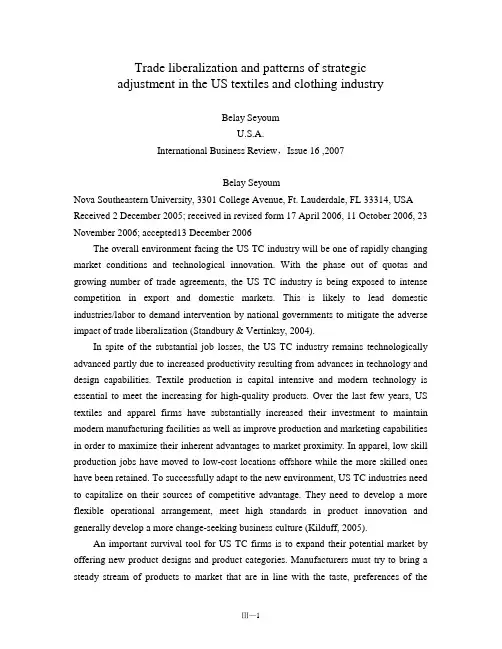
Trade liberalization and patterns of strategicadjustment in the US textiles and clothing industryBelay SeyoumU.S.A.International Business Review,Issue 16 ,2007Belay SeyoumNova Southeastern University, 3301 College Avenue, Ft. Lauderdale, FL 33314, USA Received 2 December 2005; received in revised form 17 April 2006, 11 October 2006, 23 November 2006; accepted13 December 2006The overall environment facing the US TC industry will be one of rapidly changing market conditions and technological innovation. With the phase out of quotas and growing number of trade agreements, the US TC industry is being exposed to intense competition in export and domestic markets. This is likely to lead domestic industries/labor to demand intervention by national governments to mitigate the adverse impact of trade liberalization (Standbury & Vertinksy, 2004).In spite of the substantial job losses, the US TC industry remains technologically advanced partly due to increased productivity resulting from advances in technology and design capabilities. Textile production is capital intensive and modern technology is essential to meet the increasing for high-quality products. Over the last few years, US textiles and apparel firms have substantially increased their investment to maintain modern manufacturing facilities as well as improve production and marketing capabilities in order to maximize their inherent advantages to market proximity. In apparel, low skill production jobs have moved to low-cost locations offshore while the more skilled ones have been retained. To successfully adapt to the new environment, US TC industries need to capitalize on their sources of competitive advantage. They need to develop a more flexible operational arrangement, meet high standards in product innovation and generally develop a more change-seeking business culture (Kilduff, 2005).An important survival tool for US TC firms is to expand their potential market by offering new product designs and product categories. Manufacturers must try to bring a steady stream of products to market that are in line with the taste, preferences of theconsumer. They can also expand their market potential by offering new product categories. Two of the fastest growing apparel segments in the US, for example, have been the women’s plus and men’s big and tall segments (Driscoll, 2004). Plus-size apparel marketing was estimated at $47 billion in 2005 accounting for 20% of total apparel market. It is important to identify the firm’s target customers and assess whether the firm is successfully addressing their needs.US TC firms should target a narrow segment of the market that provides the best opportunity for success. In textiles, the focus should be on a few specialized segments such as carpets, nonwovens and technical textiles. Similarly, apparel producers should increase their focus on core products, reduce vertical integration to shed overhead costs, and establish alliances with other firms to consolidate resources and increase market share.Finally, in view of rising incomes and high growth rates in many developing countries such as China, Brazil, and India, there are potential export market opportunities for US textile and apparel products. US export interests may be served by seeking improved access to the retail distribution systems of developing countries. US textile firms should also be able to use Mexico to export to the European Union and other countries, taking advantage of the Mexico-EU trade agreement. Since the conclusion of NAFTA, a number of Asian and European firms have produced certain products in Mexico in order to export to the US market.This paper suggests a demand pull model as a basis for developing a network structure in the clothing industry. In a demand pull model, consumer demand is the driver of sales unlike the supply push model whereby the manufacturer pushes goods to the retailer regardless of consumer demand.Retail companies have become powerful due to their sufficient capital and marketing expertise to build loyalty among consumers. They are the lead firm in view of their central role in the organizational network. The lead clothing retailer integrates industrial capabilities such as sourcing of textiles, design, product branding and its relations with consumers enables it to keep abreast of fashion consumption trends.The lead firm conveys its requirements to these changing trends (changes in style, material requirements) to its suppliers or subcontractors (Table 7). It also provides assistance with the purchasing of capital equipment and technology necessary to produce apparel in accordance with market demand. The fragmented webs of suppliers and subcontractors are bound together through information technology, online data sharing, joint product development, and collaborative forecasting, planning and replenishment activities. Retailers will hold less inventory as shipments become smaller and more frequent since point of sale data is directly transmitted to the manufacturer/supplier who will produce and ship garments as it is needed. This model shows the role of the retailer as an intermediary integrating the functions of design, textile sourcing, branding and as facilitator of apparel production through a web of suppliers/subcontractors. Such restructuring through technological improvements and information technology is one means of succeeding in an increasingly competitive environment. The horizontally structured, mass production methods no longer ensure future competitiveness.The lion’s share of the benefits from quota elimination is expec ted to accrue to China. Its low labor cost, high productivity, range and flexibility of services as well as efficient supplier networks will make China the supplier of choice. About 87% of apparelexecutives that participated in a cotton sourcing summit in Miami in February 2004, agreed that China will soon account for 50–90% of all apparel sold in the US market (National Labor Committee, 2004). This means rationalization of production and a massive consolidation of vendors. Other winners are likely to include India and Pakistan in narrow segments of the TC industry. The elimination of quotas is also likely to lead to lower prices for consumers in view of the absence of quota costs which is often a significant part of the cost of TC sold in the US market. Well-known brands may still hold market value since they are not subject to retail price deflation. It is important for TC firms to evaluate their internal capabilities such as sourcing, manufacturing, logistics, transportation etc. in order to develop an action plan for the post-quota world.Exporters from Latin America, Africa and the Caribbean are likely to lose market share to China since they largely compete on price (not quality) and lack the capability to produce high value added products. Even with the introduction of safeguards on a range of products that are of export interest to these countries, their US market share has declined since the phase out of quotas. With the complete removal of quotas in 2008, it is difficult for these countries to compete on price. Since the US government lifted quotas in 2002 on 29 categories, for example, China’s market share (in these categories) jumped from just 9% (2002) to 65% (2003) while prices paid by US retailers (for apparel from China) dropped by 48% (National Labor Committee, 2004). In cotton dressing gowns (quotas removed) China’s share in 2003 jumped from 25% to 39% while that of Caribbean countries fell from 13% to a mere 3%. In the first 12 months after the phase out of quotas, China’s market share in apparel rose by 59% in value while that of many Central and South American countries showed a sharp decline.What are the implications for TC firms in countries that are vulnerable to competition from China? First, they should capitalize on their proximity to the US market. Their ability to offer lower transport cost, lower lead times as well as duty free entry to the US market may attract the fashion-oriented segment of the US industry. This will depend on access to good local transport infrastructure to get goods to market as well as advanced telecommunications systems to link suppliers and customers. Local firms and governments need to collaborate in creating a climate which is conducive to business and to develop infrastructure to attract and retain TC industries that are so vital in generating exports and employment.Secondly, low wages do not necessarily provide a comparative advantage with respect to China. Firms should develop new capabilities in areas in which China does not have a comparative advantage (yarn, and silk non-apparel). This requires, inter alia, investment in modern production methods and development of competitive sources of local raw materials. Even in product areas in which China is expanding its exports, developing country suppliers that enhance their skills, technology, supply chains and marketing capabilities (through joint ventures, licensing arrangements) faster than China can still maintain their shares to the US market.Thirdly, an important strategic consideration that limits the competitive impact of China is the need on the part of multinationals to diversify their risk portfolios. US manufacturers and retailers are likely to adopt a diversified risk adjusted sourcing strategy that balances cost, speed to market as well as political and economic stability. They may not be prepared to rely on China for critical inputs beyond a certain threshold of risk. Furthermore, Mexico, Central America and the Caribbean could be attractive options for US companies in some fashion sensitive segments of the industry where quick response or fast turnaround is important.Finally, existing US rules of origin requirements to qualify for free access to the US market have had unintended consequences. One of the requirements is that they have to use US yarn and fabric. This has had the effect of making their exports less competitive. The US may have to modify its rules of origin to allow developing countries to import from Asia or other competitive sources without losing their preferential status.美国纺织品和服装产业的贸易自由化和战略调整模式贝蕾·塞尤姆美国国际商务评论,第16期,2007年贝蕾·塞尤姆诺娃东南大学,学院大道3301,劳德代尔堡,佛罗里达33314,美国2005年12月2日收到稿件;分别于2006年4月17日、2006年10月11日和2006年11月23日收到修改稿件;2006年12月13日正式录用美国纺织品和服装行业面临的是一个市场条件快速变化、科技不断创新的环境。
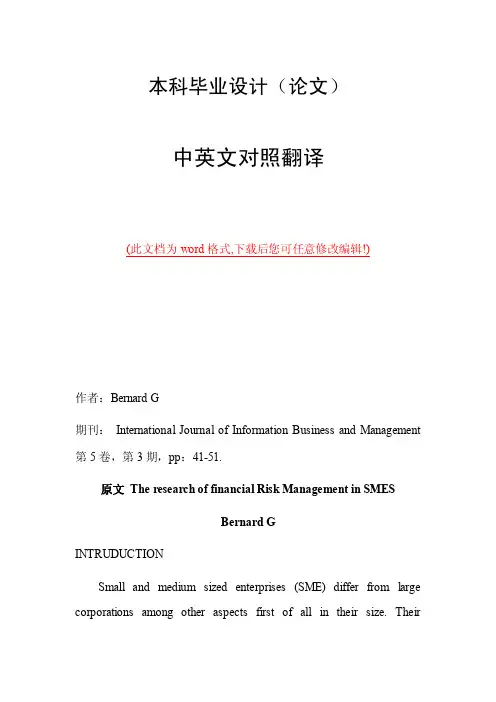
本科毕业设计(论文)中英文对照翻译(此文档为word格式,下载后您可任意修改编辑!)作者:Bernard G期刊:International Journal of Information Business and Management 第5卷,第3期,pp:41-51.原文The research of financial Risk Management in SMESBernard GINTRUDUCTIONSmall and medium sized enterprises (SME) differ from large corporations among other aspects first of all in their size. Theirimportance in the economy however is large . SME sector of India is considered as the backbone of economy contributing to 45% of the industrial output, 40% of India’s exports, employing 60 million people, create 1.3 million jobs every year and produce more than 8000 quality products for the Indian and international markets. With approximately 30 million SMEs in India, 12 million people expected to join the workforce in next 3 years and the sector growing at a rate of 8% per year, Government of India is taking different measures so as to increase their competitiveness in the international market. There are several factors that have contributed towards the growth of Indian SMEs. Few of these include; funding of SMEs by local and foreign investors, the new technology that is used in the market is assisting SMEs add considerable value to their business, various trade directories and trade portals help facilitate trade between buyer and supplier and thus reducing the barrier to trade With this huge potential, backed up by strong government support; Indian SMEs continue to post their growth stories. Despite of this strong growth, there is huge potential amongst Indian SMEs that still remains untapped. Once this untapped potential becomes the source for growth of these units, there would be no stopping to India posting a GDP higher than that of US and China and becoming the world’s economic powerhouse. RESEARCH QUESTIONRisk and economic activity are inseparable. Every business decisionand entrepreneurial act is connected with risk. This applies also to business of small and medium sized enterprises as they are also facing several and often the same risks as bigger companies. In a real business environment with market imperfections they need to manage those risks in order to secure their business continuity and add additional value by avoiding or reducing transaction costs and cost of financial distress or bankruptcy. However, risk management is a challenge for most SME. In contrast to larger companies they often lack the necessary resources, with regard to manpower, databases and specialty of knowledge to perform a standardized and structured risk management. The result is that many smaller companies do not perform sufficient analysis to identify their risk. This aspect is exacerbated due to a lack in literature about methods for risk management in SME, as stated by Henschel: The two challenging aspects with regard to risk management in SME are therefore: 1. SME differ from large corporations in many characteristics 2. The existing research lacks a focus on risk management in SME The following research question will be central to this work: 1.how can SME manage their internal financial risk? 2.Which aspects, based on their characteristics, have to be taken into account for this? 3.Which mean fulfils the requirements and can be applied to SME? LITERA TURE REVIEWIn contrast to larger corporations, in SME one of the owners is oftenpart of the management team. His intuition and experience are important for managing the company. Therefore, in small companies, the (owner-) manager is often responsible for many different tasks and important decisions. Most SME do not have the necessary resources to employ specialists on every position in the company. They focus on their core business and have generalists for the administrative functions. Behr and Guttler find that SME on average have equity ratios lower than 20%. The different characteristics of management, position on procurement and capital markets and the legal framework need to be taken into account when applying management instruments like risk management. Therefore the risk management techniques of larger corporations cannot easily be applied to SME. In practice it can therefore be observed that although SME are not facing less risks and uncertainties than large companies, their risk management differs from the practices in larger companies. The latter have the resources to employ a risk manager and a professional, structured and standardized risk management system. In contrast to that, risk management in SME differs in the degree of implementation and the techniques applied. Jonen & Simgen-Weber With regard to firm size and the use of risk management. Beyer, Hachmeister & Lampenius observe in a study from 2010 that increasing firm size among SME enhances the use of risk management. This observation matches with the opinion of nearly 10% of SME, which are of the opinion, that risk management is onlyreasonable in larger corporations. Beyer, Hachmeister & Lampenius find that most of the surveyed SME identify risks with help of statistics, checklists, creativity and scenario analyses. reveals similar findings and state that most companies rely on key figure systems for identifying and evaluating the urgency of business risks. That small firms face higher costs of hedging than larger corporations. This fact is reducing the benefits from hedging and therefore he advises to evaluate the usage of hedging for each firm individually. The lacking expertise to decide about hedges in SME is also identified by Eckbo, According to his findings, smaller companies often lack the understanding and management capacities needed to use those instruments. METHODOLOGY USE OF FINANCIAL ANAL YSIS IN SME RISK MANAGEMENT How financial analysis can be used in SME risk management? Development of financial risk overview for SME The following sections show the development of the financial risk overview. After presenting the framework, the different ratios will be discussed to finally present a selection of suitable ratios and choose appropriate comparison data. Framework for financial risk overviewThe idea is to use a set of ratios in an overview as the basis for the financial risk management.This provides even more information than the analysis of historicaldata and allows reacting fast on critical developments and managing the identified risks. However not only the internal data can be used for the risk management. In addition to that also the information available in the papers can be used. Some of them state average values for the defaulted or bankrupt companies one year prior bankruptcy -and few papers also for a longer time horizon. Those values can be used as a comparison value to evaluate the risk situation of the company. For this an appropriate set of ratios has to be chosen. The ratios, which will be included in the overview and analysis sheet, should fulfill two main requirements. First of all they should match the main financial risks of the company in order to deliver significant information and not miss an important risk factor. Secondly the ratios need to be relevant in two different ways. On the one hand they should be applicable independently of other ratios. This means that they also deliver useful information when not used in a regression, as it is applied in many of the papers. On the other hand to be appropriate to use them, the ratios need to show a different development for healthy companies than for those under financial distress. The difference between the values of the two groups should be large enough to see into which the observed company belongs. Evaluation of ratios for financial risk overview When choosing ratios from the different categories, it needs to be evaluated which ones are the most appropriate ones. For this some comparison values are needed inorder to see whether the ratios show different values and developments for the two groups of companies. The most convenient source for the comparison values are the research papers as their values are based on large samples of annual reports and by providing average values outweigh outliers in the data. Altman shows a table with the values for 8 different ratios for the five years prior bankruptcy of which he uses 5, while Porporato & Sandin use 13 ratios in their model and Ohlson bases his evaluation on 9 figures and ratios [10]. Khong, Ong & Y ap and Cerovac & Ivicic also show the difference in ratios between the two groups, however only directly before bankruptcy and not as a development over time [9]. Therefore this information is not as valuable as the others ([4][15]).In summary, the main internal financial risks in a SME should be covered by financial structure, liquidity and profitability ratios, which are the main categories of ratios applied in the research papers.Financial structureA ratio used in many of the papers is the total debt to total assets ratio, analyzing the financial structure of the company. Next to the papers of Altman, Ohlson and Porporato & Sandin also Khong, Ong & Y ap and Cerovac & Ivicic show comparison values for this ratio. Those demonstrate a huge difference in size between the bankrupt andnon-bankrupt groups.Therefore the information of total debt/total assets is more reliable and should rather be used for the overview. The other ratios analyzing the financial structure are only used in one of the papers and except for one the reference data only covers the last year before bankruptcy. Therefore a time trend cannot be detected and their relevance cannot be approved.译文中小企业财务风险管理研究博纳德引言除了其他方面,中小型企业(SME)与大型企业的不同之处首先在于他们的规模不同,但是,他们在国民经济中同样具有重要的作用。
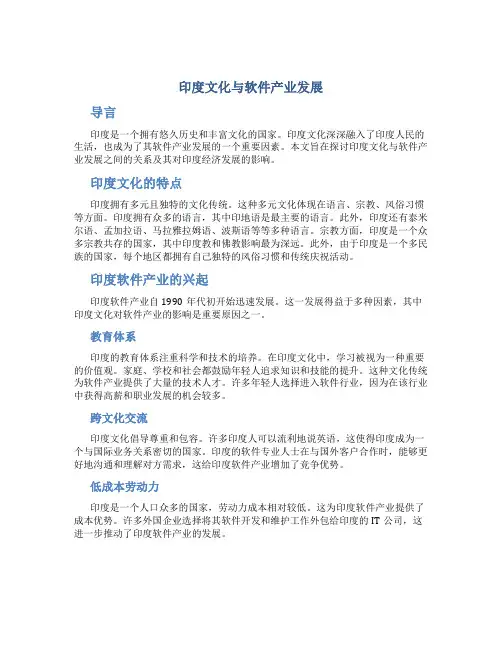
印度文化与软件产业发展导言印度是一个拥有悠久历史和丰富文化的国家。
印度文化深深融入了印度人民的生活,也成为了其软件产业发展的一个重要因素。
本文旨在探讨印度文化与软件产业发展之间的关系及其对印度经济发展的影响。
印度文化的特点印度拥有多元且独特的文化传统。
这种多元文化体现在语言、宗教、风俗习惯等方面。
印度拥有众多的语言,其中印地语是最主要的语言。
此外,印度还有泰米尔语、孟加拉语、马拉雅拉姆语、波斯语等等多种语言。
宗教方面,印度是一个众多宗教共存的国家,其中印度教和佛教影响最为深远。
此外,由于印度是一个多民族的国家,每个地区都拥有自己独特的风俗习惯和传统庆祝活动。
印度软件产业的兴起印度软件产业自1990年代初开始迅速发展。
这一发展得益于多种因素,其中印度文化对软件产业的影响是重要原因之一。
教育体系印度的教育体系注重科学和技术的培养。
在印度文化中,学习被视为一种重要的价值观。
家庭、学校和社会都鼓励年轻人追求知识和技能的提升。
这种文化传统为软件产业提供了大量的技术人才。
许多年轻人选择进入软件行业,因为在该行业中获得高薪和职业发展的机会较多。
跨文化交流印度文化倡导尊重和包容。
许多印度人可以流利地说英语,这使得印度成为一个与国际业务关系密切的国家。
印度的软件专业人士在与国外客户合作时,能够更好地沟通和理解对方需求,这给印度软件产业增加了竞争优势。
低成本劳动力印度是一个人口众多的国家,劳动力成本相对较低。
这为印度软件产业提供了成本优势。
许多外国企业选择将其软件开发和维护工作外包给印度的IT公司,这进一步推动了印度软件产业的发展。
政府支持印度政府在软件产业发展中起到了重要的推动作用。
政府制定了一系列政策和法规,为软件产业提供了支持和激励措施。
印度的政府还设立了IT专业的大学和研究机构,培养和推动软件产业的发展。
印度文化对软件产业发展的影响印度文化对软件产业发展产生了积极的影响。
首先,印度文化的教育价值观促进了软件产业的人才培养。
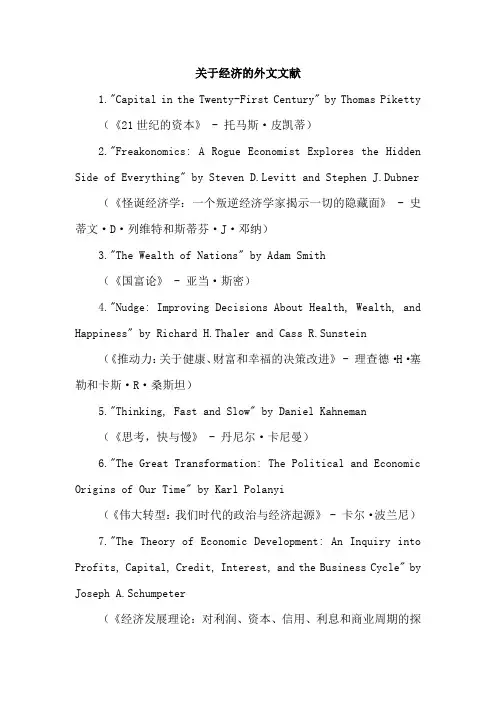
关于经济的外文文献1."Capital in the Twenty-First Century" by Thomas Piketty(《21世纪的资本》 - 托马斯·皮凯蒂)2."Freakonomics: A Rogue Economist Explores the Hidden Side of Everything" by Steven D.Levitt and Stephen J.Dubner (《怪诞经济学:一个叛逆经济学家揭示一切的隐藏面》 - 史蒂文·D·列维特和斯蒂芬·J·邓纳)3."The Wealth of Nations" by Adam Smith(《国富论》 - 亚当·斯密)4."Nudge: Improving Decisions About Health, Wealth, and Happiness" by Richard H.Thaler and Cass R.Sunstein (《推动力:关于健康、财富和幸福的决策改进》 - 理查德·H·塞勒和卡斯·R·桑斯坦)5."Thinking, Fast and Slow" by Daniel Kahneman(《思考,快与慢》 - 丹尼尔·卡尼曼)6."The Great Transformation: The Political and Economic Origins of Our Time" by Karl Polanyi(《伟大转型:我们时代的政治与经济起源》 - 卡尔·波兰尼)7."The Theory of Economic Development: An Inquiry into Profits, Capital, Credit, Interest, and the Business Cycle" by Joseph A.Schumpeter(《经济发展理论:对利润、资本、信用、利息和商业周期的探究》 - 约瑟夫·A·熊彼特)8."The End of Poverty: Economic Possibilities for Our Time" by Jeffrey D.Sachs(《贫困的终结:我们时代的经济可能性》 - 杰弗里·D·萨克斯)9."Development as Freedom" by Amartya Sen(《自由发展》 - 阿马蒂亚·森)。
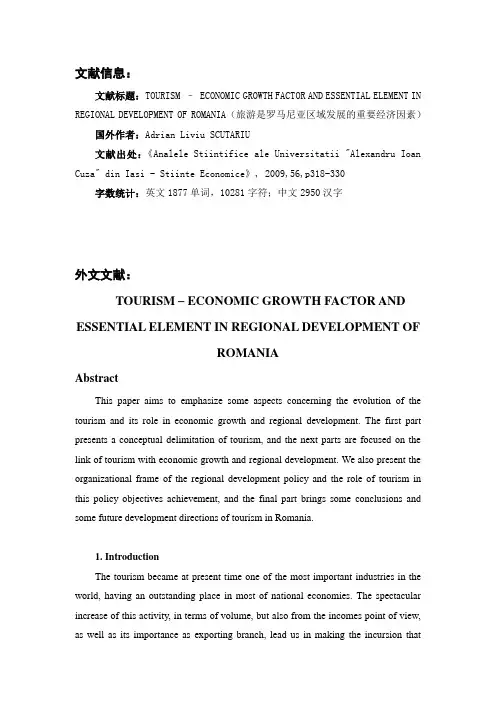
文献信息:文献标题:TOURISM – ECONOMIC GROWTH FACTOR AND ESSENTIAL ELEMENT IN REGIONAL DEVELOPMENT OF ROMANIA(旅游是罗马尼亚区域发展的重要经济因素)国外作者:Adrian Liviu SCUTARIU文献出处:《Analele Stiintifice ale Universitatii "Alexandru Ioan Cuza" din Iasi - Stiinte Economice》, 2009,56,p318-330字数统计:英文1877单词,10281字符;中文2950汉字外文文献:TOURISM – ECONOMIC GROWTH FACTOR AND ESSENTIAL ELEMENT IN REGIONAL DEVELOPMENT OFROMANIAAbstractThis paper aims to emphasize some aspects concerning the evolution of the tourism and its role in economic growth and regional development. The first part presents a conceptual delimitation of tourism, and the next parts are focused on the link of tourism with economic growth and regional development. We also present the organizational frame of the regional development policy and the role of tourism in this policy objectives achievement, and the final part brings some conclusions and some future development directions of tourism in Romania.1.IntroductionThe tourism became at present time one of the most important industries in the world, having an outstanding place in most of national economies. The spectacular increase of this activity, in terms of volume, but also from the incomes point of view, as well as its importance as exporting branch, lead us in making the incursion thatfollows, with the purpose of emphasize the role of tourism in the economic growth and regional development.2.Tourism – short conceptual delimitationsThe appearance of the tourism as an economic-organizatoric activity, at national level, took place in the second half of the twenty century, in the same time with the inclusion in the services (tertiary) sector of some new branches of national economies, generally called tourist industry.The new economic theory of tourism recognized the link between tourism and economic development of a country, the tourism being treated in a complex way, not only as recreational trip, but together with all the economic link that creates. So, at the present moment, this notion includes a whole industry, component of the services industry, which contributes at the tourist demands satisfaction, respectively: hotels, transports, entertainment.There were several different definitions given for tourism during the twenty century, but we will focus on some present approaches, accepted by most of the specialists of the field.The tourism can be shortly defined as being [Minciu, Baron, Neacu, 1991, 1993] an economic-social phenomenon specific for the modern civilization, strongly anchored in the life of the society and influenced by its evolution, with a high dynamism and having large social segments as target. It involves a large human capital and influences the evolution of the economy and society.So, one can notice, that, in the tourism definition, appeared more and more elements referring to the industry that handles the tourist need satisfaction, fact also revealed by The Little Encyclopedic Dictionary, which considers tourism as “a side of the tertiary sector of the economy, where the goal of the provided activity is the organization and ongoing of entertainment trips, or of persons travels at various congresses and meetings, including all the necessary activities for the consuming and services needs satisfaction of the customers".In order to clarify the aspects regarding the tourist phenomenon definition, onecan use the inductive method in order to get to a most possible comprehensive definition, aiming to retain the main elements that are characteristic for the tourist activity [Neacu, Baron, Snak, 2006, 21]:• travel of the persons during their trip;• the stay in a settlement out of their domicile (permanent residence) of the person that travels;• the stay have a limited period;• the stay doesn’t become a definitive residence.Continuing the anterior ideas, we will mention a definition variant, that includes the business travels, too, proposed by the professor dr. Claude Kaspar (the president of the International Association of the Scientific Experts in Tourism (A.I.E.S.T.)): “The tourism is an ensemble of relations and facts constituted from the travel and the stay of the persons for which the place of stay is not their home and not the principal place of their professional activity”.Considering the role and the economic-social importance of the intern (national) tourism, The World Tourism Organization (WTO) elaborated a definition of the national tourism, so we can consider national tourist any person which visits a place that is not his/her usual residence, situated inside his/her residence country and having a different purpose that a remunerated activity and with a staying of at least one night .3.The place and role of tourism in the economyTourism, as an important element of the tertiary sector and industry with huge potential, has an increasingly role in the economy of a country, being a factor which the economic growth is based on.By "economic growth" we mean a complex process involving the entire economic system, which is determined by the results of economic activity and is considered the only factor that ensures the economic success in the long term of each state.The tertiary or services sector has become prevalent in the postwar period, itsrole becomes more important, diversifying its activities in terms of content, taking different forms of expression, which have expanded and diversified ways of achieving social product, thus becoming a significant component of the reproduction mechanism. In developed countries this sector weightings are high.The services sector, as any other sector, experienced a development from early forms of the basic activities up to actual structures, which are characterized by a maximum utility for individuals and society.Tourism, as economic activity, includes various services that derive from the basic ones: information, placement of tourist travels, accommodation, food selling, offering treatments, as well as leisure and entertainment.Tourist offer increased both quantitatively and qualitatively, giving rise to a genuine industry of tourism, which requires the consideration of the tourism phenomenon as a growing distinct branch of the national economy, component of the tertiary sector. Separate treatment come from the complexity and specific nature compared to traditional branches of an economy. However, tourism is in close connection with the development of other sectors, being a consequence branch.As socio-economic changes in the contemporary era have created and developed tourism, this in turn bringing by default a specific demand for goods and services necessary to consolidate tourism product, it stimulates some productive sectors such as: industry, agriculture, construction, transport, trade, communications, culture, healthcare, etc.From the expenditures of the tourist-consumer of goods and services, which turns into money for the economic units of tourism industry (transport, accommodation, food, recreation, treatment etc.), some goes directly to those units as profits and cash funds for pay their workers, some goes to the state budget as taxes, fees, and another part reach other branches of the economy as payment for goods delivered and services rendered by them for the needs of tourism industry.Considering tourist products consumed by foreign visitors during their stay, international tourism will appear as a form of "invisible export", with advantages such as the duty free sale of products to foreign tourists into the country. Therefore,tourism has often a higher labor efficiency than classical export of goods, and some of them, consumed by tourists during the stay, nor would be subject of classic export because of being perish, of their costs of transport or other prohibitive measures.Due to the economic advantage of international tourism, many developing countries have taken steps to develop their tourism industry, this form of "invisible trade" in the economy could bring large quantities of currency.Some statistical data come to support the previous statements. The spectacular development of tourism in the last period can be observed also from the fact that the total number of tourists traveling abroad have increased from 1995 to 2008, becoming almost twice (Figure no.1).Source: O.M.T., UNWTO World Tourism Barometer, V olume 7, No.1, January 2009Figure no.1. International tourist arrivals (millions) The exemplification of the tourism place may also come from the fact that in The E.U. Member States about 20 million people are directly or indirectly involved in tourism, the share of it in the creation of gross domestic product of these countries being on average of about 4% [Postelnicu, 1997 , 53].4. The role of tourism in the regional development objectives achievementThe regional development policy main objective is to reduce the economic and social disparities that exists between the various regions of Europe.Several of the regional development policies objectives can be achieved by boosting a field of activity that has some undisputed aces: the tourism. In this part of the paper, we in tend to succinctly design some arguments for the ideas formerly expressed concerning the role of tourism in the regional development.The sustainable regional development must necessarily correlate and integrate the Romanian tourism, between the other components of the local economy, taking also into account that this clean industry does not affect the environment, and, generally, does not requires big investments. A good sustainable development project, included in a regional development program, supposes the less investments costs in this activity, the more harmoniously the integration is made. The tourism can become an important component of the economy, which could cause important changes in territorial profile, contributing at economic and social development of some regions less developed.The tourism can contribute more than other sectors at the achievement of some larger objectives, established by governments as priorities in the general interest of the citizens: fighting against poverty, life conditions improvement, currency receipts increasing, the intensification of the links between countries and even political purposes.The general objective of the regional development policy, reducing existing regional imbalances, with emphasis on balanced growth and revitalization of disadvantaged areas can be reached also by stimulating the areas with tourist potential, for which the tourism would represent one of the less possibilities of standard of living and development increase (especially in the rural areas). The development of the tourism by the capitalization of the existing potential can lead also to the achievement of one of the ERDF objectives.The ERDF financing explicitly supports the tourism development and the investments in the cultural patrimony, including its protection and th e natural one’s, with the condition of creating labor places.5. ConclusionsIn the actual period, the tourism became an outstanding element of the tertiary sector, having an important role in the economy of a country and being one of the factors that contribute at the economic growth.As we presented, the tourism had an extraordinary development all over the world, the number of tourists being twice as much than 15 years ago, and the incomes from tourism increased considerably. Its effects can be noticed in the development of its good and services suppliers’ branches, the whole economy of the zone being stimulated in this way, through the so-called multiplier effect. At the tourism stimulation, as branch that doesn’t need important investments and don’t a ffect environment, the development policies can successfully contribute.After a general presentation of the regional development coordinates in Romania, we designed some development possibilities for the tourism with the help of the founds that can be accessed through this policy. In Romania there is an important potential for the tourism development. There are several causes for which the tourist activity level is not as high as the existing potential, such as: infrastructure low developed or the low quality of the services. By accessing these founds, several of the deficient aspects can be improved. The sums are considerable, but it is necessary to increase the absorption capacity for the available founds.中文译文:旅游是罗马尼亚区域发展的重要经济因素摘要本文旨在强调一些因素对旅游业发展演变的影响和旅游业在经济增长、区域发展中的作用。
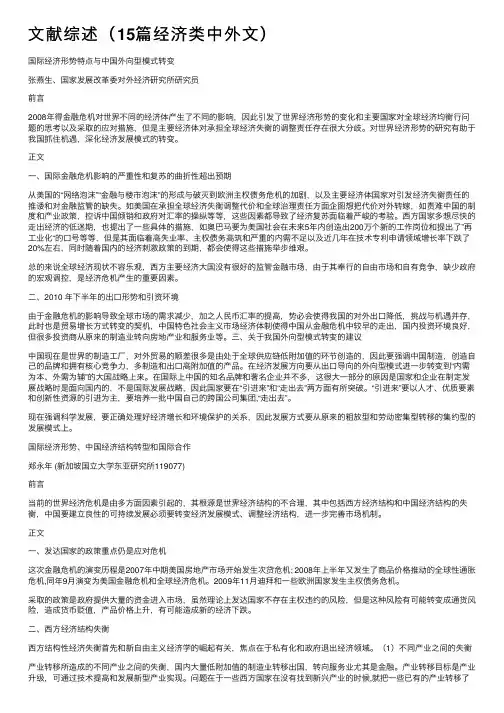
⽂献综述(15篇经济类中外⽂)国际经济形势特点与中国外向型模式转变张燕⽣、国家发展改⾰委对外经济研究所研究员前⾔2008年得⾦融危机对世界不同的经济体产⽣了不同的影响,因此引发了世界经济形势的变化和主要国家对全球经济均衡⾏问题的思考以及采取的应对措施,但是主要经济体对承担全球经济失衡的调整责任存在很⼤分歧。
对世界经济形势的研究有助于我国抓住机遇,深化经济发展模式的转变。
正⽂⼀、国际⾦融危机影响的严重性和复苏的曲折性超出预期从美国的“⽹络泡沫”“⾦融与楼市泡沫”的形成与破灭到欧洲主权债务危机的加剧,以及主要经济体国家对引发经济失衡责任的推诿和对⾦融监管的缺失。
如美国在承担全球经济失衡调整代价和全球治理责任⽅⾯企图想把代价对外转嫁,如责难中国的制度和产业政策,控诉中国倾销和政府对汇率的操纵等等,这些因素都导致了经济复苏⾯临着严峻的考验。
西⽅国家多想尽快的⾛出经济的低迷期,也提出了⼀些具体的措施,如奥巴马要为美国社会在未来5年内创造出200万个新的⼯作岗位和提出了”再⼯业化“的⼝号等等,但是其⾯临着⾼失业率、主权债务⾼筑和严重的内需不⾜以及近⼏年在技术专利申请领域增长率下跌了20%左右,同时随着国内的经济刺激政策的到期,都会使得这些措施举步维艰。
总的来说全球经济现状不容乐观,西⽅主要经济⼤国没有很好的监管⾦融市场,由于其奉⾏的⾃由市场和⾃有竞争,缺少政府的宏观调控,是经济危机产⽣的重要因素。
⼆、2010 年下半年的出⼝形势和引资环境由于⾦融危机的影响导致全球市场的需求减少,加之⼈民币汇率的提⾼,势必会使得我国的对外出⼝降低,挑战与机遇并存,此时也是贸易增长⽅式转变的契机,中国特⾊社会主义市场经济体制使得中国从⾦融危机中较早的⾛出,国内投资环境良好,但很多投资商从原来的制造业转向房地产业和服务业等。
三、关于我国外向型模式转变的建议中国现在是世界的制造⼯⼚,对外贸易的顺差很多是由处于全球供应链低附加值的环节创造的,因此要强调中国制造,创造⾃⼰的品牌和拥有核⼼竞争⼒,多制造和出⼝⾼附加值的产品。
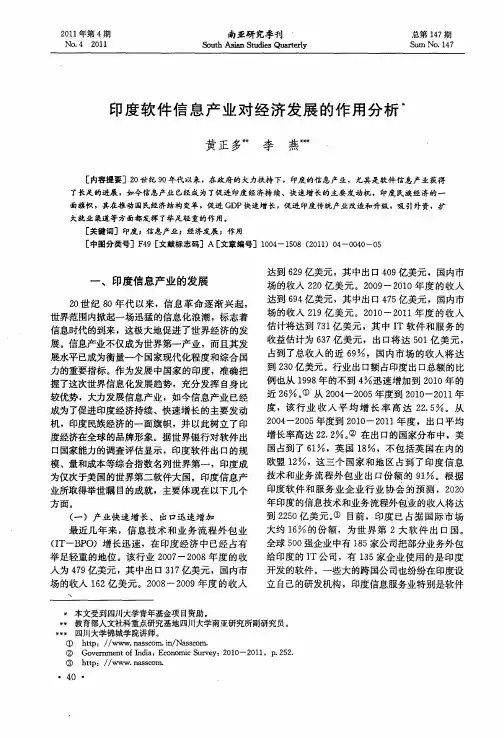
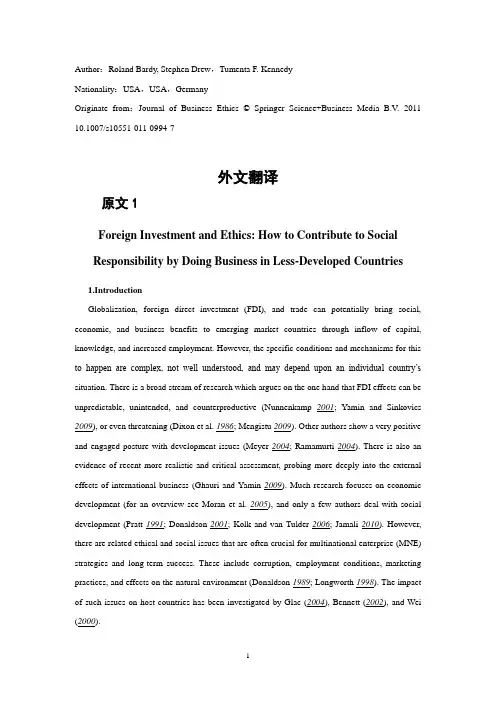
Author:Roland Bardy, Stephen Drew,Tumenta F. KennedyNationality:USA,USA,GermanyOriginate from:Journal of Business Ethics © Springer Science+Business Media B.V. 2011 10.1007/s10551-011-0994-7外文翻译原文1Foreign Investment and Ethics: How to Contribute to SocialResponsibility by Doing Business in Less-Developed Countries1.IntroductionGlobalization, foreign direct investment (FDI), and trade can potentially bring social, economic, and business benefits to emerging market countries through inflow of capital, knowledge, and increased employment. However, the specific conditions and mechanisms for this to happen are complex, not well understood, and may depend upon an individual country’s situation. There is a broad stream of research which argues on the one hand that FDI effects can be unpredictable, unintended, and counterproductive (Nunnenkamp 2001; Yamin and Sinkovics 2009), or even threatening (Dixon et al. 1986; Mengistu 2009). Other authors show a very positive and engaged posture with development issues (Meyer 2004; Ramamurti 2004). There is also an evidence of recent more realistic and critical assessment, probing more deeply into the external effects of international business (Ghauri and Yamin 2009). Much research focuses on economic development (for an overview see Moran et al. 2005), and only a few authors deal with social development (Pratt 1991; Donaldson 2001; Kolk and van Tulder 2006; Jamali 2010). However, there are related ethical and social issues that are often crucial for multinational enterprise (MNE) strategies and long-term success. These include corruption, employment conditions, marketing practices, and effects on the natural environment (Donaldson 1989; Longworth 1998). The impact of such issues on host countries has been investigated by Glac (2004), Bennett (2002), and Wei (2000).2.Incentive and Advantage Based EthicsPre-modern philosophy considered (universal) standards as given. We argue that a different approach which comes closer to relativism and even constructivism is needed in contemporary complex global business. Homann (2002) states that in the age of globalization, moral foundations should be based on advantages and incentives, and that ethics is not about following rules, but about developing them, i.e. not about just following rules but setting the rules of the game. With so-called “incentive- and advantage based ethics” (Luetge 2005), the question is not whether altruism or other nonadvantage seeking behaviors are historic anachronisms nor if practice has proven that only self-interested behavior leads to beneficial economic result.There is a long tradition—both in public and academic discourse—of discussing the tension-filled relationship between profit and morality under competitive market circumstances (Hemphill 2004). Often, proof is sought by recurring to a list of moral concerns, which includes environmental pollution, global warming, child labor, human rights violations, the deterioration of social standards like job security, and the fight against corruption. In these instances, and in many more, what for a long time has been looked at as clash between private interest and public interest, is now becoming a collaborative issue. Private business firms seem increasingly willing to take on the role of corporate citizens by embracing the rights and duties of political actors. They have engaged in rule-finding discourses as well as rule-setting processes in which they actively cooperate with government actors and/or civil society organizations. But what are their motives and their incentives, and what is required to encourage the pursuit of ethical behavior? One answer lies with what Boatright (1999) has called the “mistake” on which business ethics often rest.3.Attracting and Conducting FDI: A Two-Way StreetThrough FDI, a company not only penetrates a host country’s m arket, it may also gain access to resources, economies of scale and scope in production, logistics, and marketing processes. Important markets include supply chains, distribution networks, and end customers. Whether a firm chooses FDI rather than serving foreign markets through exporting, licensing, alliances, or other means is determined by three factors (Dunning and Lundan 2008). These include: a transferable competitive advantage in the home-market, specific characteristics of the foreign market which allow the firm to exploit its competitive position in that market, and the firm’s ability to increase its competitive position by taking advantage of what the host country has tooffer for controlling the entire value-chain. All three conditions must be present or FDI may not take place (Dunning and Lundan 2008). The firm-specific advantages which constitute spillover effects of FDI (proliferation of technology, secondary employment, and enhancement of skills) are often what less-developed countries need for their growth and development. The host country and the investor may focus on the location-specific advantages as factors to entice higher levels of FDI inflows.When the three conditions as stated above are missing then FDI either does not occur or occurs only at very low levels. This explains why some areas of the world, especially the poorest, fail to attract FDI. Although FDI flows to Africa have increased in recent years, these represent only a small portion of the total flows to developing countries. Average annual FDI flows increased from US $ 2.2 bn. in 1980, to 15 bn. during the period 2000–2004. However, Africa’s share of global flows fell from 2.3% in 1980 to about 1.5% during 2000–2004. As a percentage of total flows to developing countries, Africa’s share fell from 10% in 1980 to 7% during 2000–2004 (Cleeve 2009). Local infrastructure, effective macroeconomic policy, and reliable data of possible host nations are decisive in choice of location for foreign firms. These are often lacking in Africa.Knowledge of a country or region is crucial in the choice of location, and without this, investors may underestimate entrepreneurial opportunities or overestimate risks, pushing such locations to the periphery of the decision-making process. But there are investment opportunities in almost any region of Africa. According to UNCTAD (2011a), Africa offers the highest return on FDI in the world, far exceeding all other regions. While not yet as competitive as the BRIC countries, the demographics bode well for Africa as a market as more than half its population is under the age of 24. Europe’s population will lose 60 million people by 2050, however, Africa will add 900 milli on. Ironically, Africa’s very poverty creates opportunities: Education; healthcare; infrastructure; banking the unbanked; and middle class aspirational consumer goods etc. (Luiz 2010). Some areas in sub-Saharan Africa still have deficiencies in all these areas, and more often than not, the risk profile is heightened by political and institutional instability and unpredictability and high levels of corruption (Ngowi 2001). Investors need reliable information, but too often the official statistics are lacking or unreliable and official sources cannot provide robust data on markets, business partners, and available labor (Kennedy 2011).Unfortunately, when reliable information is absent, and when all ingredients of a riskyenvironment are present, the vicious cycle of poverty continues. FDI does not take place and the associated possible benefits cannot be exploited. This is where the instruments of solidarity with the poor and strong transnational institutions have a vital role. The International Development Association (IDA) is a division of the World Bank that helps the world’s poorest countries. IDA complements the World Bank’s other lending arm, the International Bank for Reconstruction and Development (IBRD), which serves middle-income countries with capital investment and advisory services. IBRD and IDA share the same staff and evaluate projects with the same rigorous standards. These common standards encourage private investors to follow suit and resolve the informational and infrastructural deficits.4.Cases from Sub-Saharan CountriesIn the Republic of South Africa, quite a few investments have been directed at the specifics of this region’s consumers and producers. One of the biggest FDI deals of 2001 was Saudi Oger’s USD180 million investment in Cell C, the new cellular operator. Also in 2001, Malaysian Resources Corporation announced a USD 200million property development. Global Environment Fund acquired forestry assets worth USD150 million billion from Mondi and formed Global Forest Products,signaling its intention to bid for state-owned forestry assets. These ventures not only contribute to improving the base for follow-up investments that broaden the opportunities for local small businesses, they are also directed toward improving communication throughout rural areas and providing new skills to hitherto unskilled labor (Akinboade et al. 2006).The second case is from Uganda, which in the past was shunned by investors, but has over the past 20 years attracted a significant number of investors mainly in response to the implementation of far-reaching economic and structural reforms. Privatization of state enterprises and the return of confiscated enterprises and properties to the Asians who had been expelled form the country during the Idi Amin dictatorship, have positively affected the attraction of FDI. But a major impact on social development stems from the services sector FDI which has grown rapidly in Uganda. Typical of this is accounting and computer services, warehousing, transportation and communication, and other services to support the manufacturing sector. In addition, the liberalization of the economy coupled with local demand for services like mobile telephony has attracted investments from big players on both the regional and international scene, such as V odafone and MTN.Another example for positive FDI effects is the agro-business investments in various sub-Saharan states. In recent years, agriculture is being perceived as a sector that not only offers investment opportunities for the private sector but also a drives local development of agriculture-related industries and the rural nonfarm economy (World Bank 2007). In East Africa, fisheries are an expanding sub-sector due to the presence of some of the largest fresh water lakes in the world. Lake Victoria, half of which is in Uganda, is the second largest freshwater lake in the world. Similarly, Ghana, Côte d’Ivoire and Cameroon have a ttracted investments in cocoa processing as a result of suitable agro-climatic conditions for cocoa production.From this type of investments, the low-skilled labor force which is employed in subsistence farming purposes is being converted into skilled labor with processed foods gaining prominence in both domestic and global markets. And the primary investments spur follow-ups like the DrumNet project implemented launched by Pride Africa that uses a mobile phone interface to link smallholder farmers to ban ks, farm input suppliers and agricultural buyers.The project’s premise is that information on the market is one of the key elements that keeps farmers from getting the full market value for their products. This lack of information keeps the farmers in a disadvantageous financial position, making it difficult for them to obtain the financing and resources they need to grow their business. DrumNetprovides marketing, financial, and informational services aimed at stimulating wealth creation and the economic integration of smallholder farmers.To conclude this list of examples, reference shall be made to private sector participation in agricultural water development, which has been developing over the last decade in e.g. Kenya, Niger, and Cameroon. Private investment here uses increased technologies for in-field rainwater management for dryland crops, the objective of which is to increase the effectiveness of rainfall to stabilize and enhance yields. The most promising of these are the various types of conservation farming, including deep tillage, reduced tillage, zero tillage, and various types of planting basins, all of which have been successfully demonstrated in many parts of the region, both in the semi-arid and dry sub-humid zones. The results have been impressive, particularly when the technology input has been combined with what is called “Farmers’ Field Schools”.5.Summary and TrendsThe current wave of globalization has intensified the competition for FDI among developing countries, and all actors share responsibility to make changes in attitudes, policies, and structures(Dupasquier and Osakwe 2005). International organizations, national governments, business, labor, civil society, and the media each have important roles to play.Opportunistic and short-term ventures driven only by the profit motive are becoming less acceptable, bringing corporations pursuing such strategies into disrepute, and making them targets for a technology-enabled global community of activists and NGOs. Strategies that not only add to business value but also lead to long-term economic and social improvements are increasing in significance. Profit seeking by, e.g., selling luxury goods or high-end eco-tourism destinations to an elite of wealthy customers and using parts of the profit to address social inequality issues, will not be sufficient. Serving the needs of customers at the top of the pyramid is becoming less important than meeting the needs of those at the bottom of the pyramid and the increasing ranks of the middle classes with similar ambitions to their counterparts in developed nations. It also seems the world has started to commit itself to a number of principles and values. Fair globalization means making these values an integral part of the process of global economic integration.This paper has highlighted the complexity and challenges of moving to a more socially responsible vision of capitalism across borders. There is a wide body of theoretical and empirical literature on the economic effects of FDI. However, studies addressing the links between cross-border business and ethical considerations are less abundant. This paper describes a growing body of study and evidence relating FDI, ethics, CSR, and poverty alleviation. We have addressed poverty alleviation as a key question for global ethics and in particular sub-Saharan Africa.译文1国外投资和道德标准:在欠发达国家如何通过商业经营为社会责任做出贡献1.导言经济全球化,外商直接投资(FDI),和贸易通过资本和知识的流入很可能为新兴市场国家带来社会、经济和商业利益,增加就业机会。
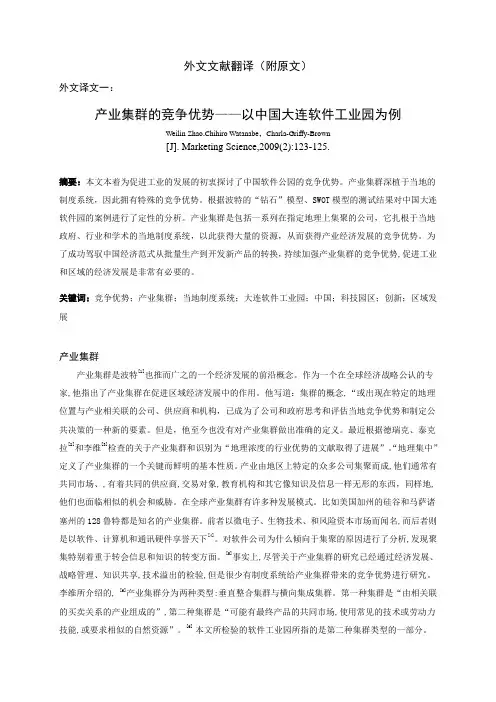
外文文献翻译(附原文)外文译文一:产业集群的竞争优势——以中国大连软件工业园为例Weilin Zhao,Chihiro Watanabe,Charla-Griffy-Brown[J]. Marketing Science,2009(2):123-125.摘要:本文本着为促进工业的发展的初衷探讨了中国软件公园的竞争优势。
产业集群深植于当地的制度系统,因此拥有特殊的竞争优势。
根据波特的“钻石”模型、SWOT模型的测试结果对中国大连软件园的案例进行了定性的分析。
产业集群是包括一系列在指定地理上集聚的公司,它扎根于当地政府、行业和学术的当地制度系统,以此获得大量的资源,从而获得产业经济发展的竞争优势。
为了成功驾驭中国经济范式从批量生产到开发新产品的转换,持续加强产业集群的竞争优势,促进工业和区域的经济发展是非常有必要的。
关键词:竞争优势;产业集群;当地制度系统;大连软件工业园;中国;科技园区;创新;区域发展产业集群产业集群是波特[1]也推而广之的一个经济发展的前沿概念。
作为一个在全球经济战略公认的专家,他指出了产业集群在促进区域经济发展中的作用。
他写道:集群的概念,“或出现在特定的地理位置与产业相关联的公司、供应商和机构,已成为了公司和政府思考和评估当地竞争优势和制定公共决策的一种新的要素。
但是,他至今也没有对产业集群做出准确的定义。
最近根据德瑞克、泰克拉[2]和李维[3]检查的关于产业集群和识别为“地理浓度的行业优势的文献取得了进展”。
“地理集中”定义了产业集群的一个关键而鲜明的基本性质。
产业由地区上特定的众多公司集聚而成,他们通常有共同市场、,有着共同的供应商,交易对象,教育机构和其它像知识及信息一样无形的东西,同样地,他们也面临相似的机会和威胁。
在全球产业集群有许多种发展模式。
比如美国加州的硅谷和马萨诸塞州的128鲁特都是知名的产业集群。
前者以微电子、生物技术、和风险资本市场而闻名,而后者则是以软件、计算机和通讯硬件享誉天下[4]。
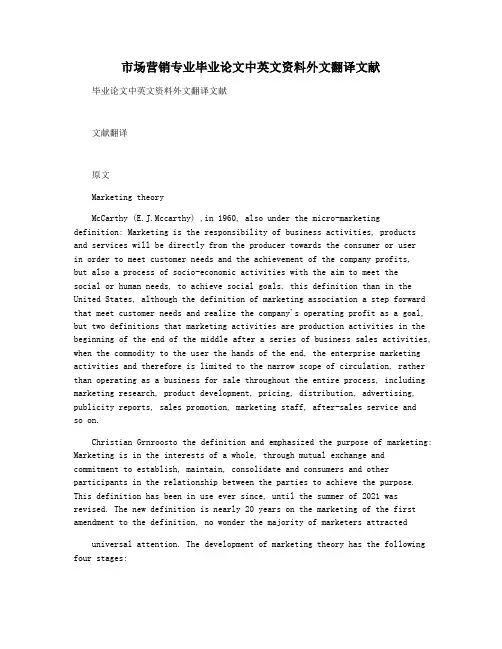
市场营销专业毕业论文中英文资料外文翻译文献毕业论文中英文资料外文翻译文献文献翻译原文Marketing theoryMcCarthy (E.J.Mccarthy) ,in 1960, also under the micro-marketingdefinition: Marketing is the responsibility of business activities, products and services will be directly from the producer towards the consumer or userin order to meet customer needs and the achievement of the company profits,but also a process of socio-economic activities with the aim to meet thesocial or human needs, to achieve social goals. this definition than in the United States, although the definition of marketing association a step forward that meet customer needs and realize the company's operating profit as a goal, but two definitions that marketing activities are production activities in the beginning of the end of the middle after a series of business sales activities, when the commodity to the user the hands of the end, the enterprise marketing activities and therefore is limited to the narrow scope of circulation, rather than operating as a business for sale throughout the entire process, including marketing research, product development, pricing, distribution, advertising, publicity reports, sales promotion, marketing staff, after-sales service andso on.Christian Grnroosto the definition and emphasized the purpose of marketing: Marketing is in the interests of a whole, through mutual exchange and commitment to establish, maintain, consolidate and consumers and other participants in the relationship between the parties to achieve the purpose. This definition has been in use ever since, until the summer of 2021 was revised. The new definition is nearly 20 years on the marketing of the first amendment to the definition, no wonder the majority of marketers attracteduniversal attention. The development of marketing theory has the following four stages:The first stage: start-up phase. Marketing in the late 19th century to 20 in the United States the world's creation of 20, due to industrial development and marketing at this time by a very narrow scope of the study, but research and commercial advertising network settings. Island in Illinois and other related courses at the universities. By the \of American Advertising\to\Advertising and Marketing Association of Science Teachers\to marketing research to ensure the organization. At this time of marketing research is characterized by: a. focus on marketing and advertising techniques, modern marketing theory, concepts, principles had yet to emerge; b. University research activities are basically confined to the classroom and a professor of the study, and also society and the business community did not receive attention.Phase II: Application stage. During the 20th century to the end of World War II 20 for the application stage, begun to take shape at this time, the United States began large-scale domestic enterprises to use marketing to operate businesses, open overseas markets, European countries have to follow. Established in 1931, \Marketing Association\Marketing preach, and in 1937 merged the two organizations, academia and the business community to absorb a wide range to join the Marketing from the University of the rostrum to the community. This stage of the development of marketing in the applications. The capitalist world in 1929 due to the outbreak of an unprecedented economic crisis, the economy of the Great Depression, large shrinkage in the purchasing power of a sharp decline in the community, the unprecedented sharp market. The whole capitalist economic crisis dealt a serious blow. This stage, marketing research is characterized by: a. there is no product to sell out of this narrow concept of; b. at a deeper study on the basis of a broader marketing and advertising technique; c. study in favor of selling the business organization set; d. beginning of the study of marketing theory to society, paying attention to the general business community.The third phase: the formation period of development. The 20th century, the 50's to 80's for the marketing stage of development, the U.S. military-industrial economy has begun to shift the public economic, social goods, the sharp increase in social productivity improved significantly, while the corresponding consumption level of residents has not been much improvement, market began to emerge in a state of oversupply. At this point the U.S. marketing expert R. Cox and W. Aderson the \sense of Marketing is to promote the potential producers and consumers of goods or services of any transaction activity.\the new marketing stage. Previously that the market is the end ofthe production process, is now considered to be the starting point of the production process; the original that is marketing to sell products, now that marketing through the investigation to understand the needs and desires of consumers, and production in line with consumer needs and desires goods or services, which meet the needs and desires of consumers; so that from the marketing companies to enter the framework of social vision and a clear management guidance.Phase IV: the mature stage. Since the 80's for the marketing of the mature stage, in: a. associated with other disciplines such as economics, mathematics, statistics, psychology, etc.; b. theory began to form their own system; 80 is the age of marketing revolutionary period, begun to enter the field of modern marketing, so marketing the new look.译文市场营销理论麦卡锡(E.J.Mccarthy)于1960年对微观市场营销下了定义:市场营销是企业经营活动的职责,它将产品及劳务从生产者直接引向消费者或使用者以便满足顾客需求及实现公司利润,同时也是一种社会经济活动过程,其目的在于满足社会或人类需要,实现社会目标。
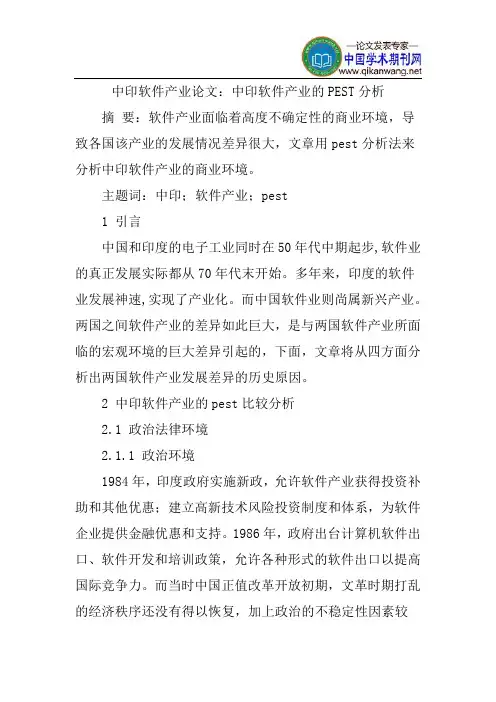
中印软件产业论文:中印软件产业的PEST分析摘要:软件产业面临着高度不确定性的商业环境,导致各国该产业的发展情况差异很大,文章用pest分析法来分析中印软件产业的商业环境。
主题词:中印;软件产业;pest1 引言中国和印度的电子工业同时在50年代中期起步,软件业的真正发展实际都从70年代末开始。
多年来,印度的软件业发展神速,实现了产业化。
而中国软件业则尚属新兴产业。
两国之间软件产业的差异如此巨大,是与两国软件产业所面临的宏观环境的巨大差异引起的,下面,文章将从四方面分析出两国软件产业发展差异的历史原因。
2 中印软件产业的pest比较分析2.1 政治法律环境2.1.1 政治环境1984年,印度政府实施新政,允许软件产业获得投资补助和其他优惠;建立高新技术风险投资制度和体系,为软件企业提供金融优惠和支持。
1986年,政府出台计算机软件出口、软件开发和培训政策,允许各种形式的软件出口以提高国际竞争力。
而当时中国正值改革开放初期,文革时期打乱的经济秩序还没有得以恢复,加上政治的不稳定性因素较多,同时那几年通货膨胀比较严重,国家将心思全力投入到稳定经济社会上面去,对科技创新没有过多关注,没能给软件产业提供发展的政策支持,导致我国软件产业在很长一段时期内得不到良好的发展。
2.1.2 法律环境印度政府非常重视制定和完善法律法规,保护软件知识产权。
印度有关部门严厉打击各种盗版犯罪,切实做到了"有法可依、执法必严、违法必究"。
印度政府还努力增强软件用户的版权意识,软件盗版率已经接近西欧国家的水平。
而我国在相当长一段时期内,都没有知识产权相关保护的法律规定,导致我国制假、盗版等侵权行为泛滥,虽然后来在国际压力下,我国逐渐制定了知识产权保护的相关法律来保护科技创新,但是由于目前我国还处于知识产权保护的起步阶段,有很多环节都不够完善,在这种法律环境下,而盗版严重,导致正版销量大幅减少,使研发成本不能得以收回,因此,挫败了企业的创新动力。
乡村旅游和经济发展外文翻译文献乡村旅游和经济发展外文翻译文献Rural Tourism and Economic DevelopmentTourism is a popular economic development strategy. The author reviews three diverse books that study tourism from various social science perspectives——economic, sociological,psychological,and anthropological.Ryan’s book is multidisciplinary in approach and covers all major topics of tourism;tourist experience;and marketing.Michal Smith details the negative affects of tourism development in rural areas of the southeastern United States.Finally,Valene Smith’s book presents international case studies that document cultural changes caused by tourism development. Despite their different focuses, all three books agree that tourism development has its benefits and costs and that changes to the destination areas are inevitable. Careful planning and marketing can lessen the harmful effects of tourism development.Tourism is an increasingly popular elixir to economic rural and urban underdevelopment. Its current prominence in the array of local economic development strategies can be traced to several features of the tourism industry. Tourism jobs are mostly low-skill jobs, which are a good fit with the job skills of many rural residents. Also, tourism has a potential for creating an export base that builds on favorable local advantages such as a pleasant climate or sites of historic or natural interest. More important, tourism strategies mesh with the current political philosophy and budget realities ofminimizing government involvement and investment. The accommodations,restaurants,and entertainment activities that necessarily accompany tourism are assumed to be provided by the private sector. Critics of tourism as a development strategy cite its low-paying and dead-end jobs, its degradation of the local natural environment, and its potential corruption of local culture and customs. Further, not every jurisdiction in need of jobs and a tax base has tourism potential.The study of tourism, like much of the economic development literature, draws from a wide range of disciplines. The forte of economists is in addressing the affects of tourism on the local economy;however,economists fail to describe who tourists are or why they travel.Anthropologists’major contribution to defining and studying tourism is in examining the impacts of tourism on local culture. Psychologists are more likely to dwell on the motives for tourism, but they ignore the impacts. Clearly, the complete definition of tourism includes the economic,social,anthropological,and psychological viewpoints. One strength of Recreational Tourism: A social Science Perspective by Chris Ryan is its multidisciplinary approach to the study of tourism. In contrast, the case studies from around the world found in Hosts and Guests:TheAnthropology of Tourism, edited by Valene Smith, dwell on tourism from the perspectives of history and anthropology, with its focus on the culture affects of tourism and tourism’s role in the acculturation process. Behind the Glitter: The Impact of Tourism on Rural Women in the Southeast, by Michal Smith, focuses on the economic and cultural effects of tourism in the rural Southeast.Benefits of tourismPerhaps chief among the advantages of tourism is that it is seen as obtainable, even for communities with minimal public resources. Most communities envision negligible public investments such as new roads, history markers, town cleanup, storefront rehabilitation, and marketing. The private sector is expected to provide hotels, motels, restaurants, entertainment, and other tourist accommodations.Second, tourism is a relatively easy-to-understand concept for the lay public and can, therefore, generate local support. Community pride leads residents to conclude that their home town has something to offer tourists.Tourism builds on perceived and existing local advantages or amenities, such as sites of historical interest, mountains and other places of natural beauty,pleasant climates,or clean air.Tourismdevelopment uses these resources, which are “free” i n the sense that the tourism industry has not paid for them. In some cases, these natural resources would have small economic value without tourism development.Mieczkowske cites the Alps,“dying” fishing or mill towns of New England and the Canadian Maritime provinces,and Caribbean islands as places where tourism has given economic value to natural amenities. Thus tourism can have a positive economic effect in such areas of otherwise low economic productivity.Third, decades of experience in smokestack chasing has been disappointing for many communities.The competition for manufacturing plants is intense and as long as manufacturing employment continues its downward trend, competition for the remaining plants will only increase.Also,tourism is perceived as a cleaner industry for the environment than is manufacturing.Fourth, rural tourism havens tend to be growth. This decade became known as the population turnaround as it was the first time in the history of the United States the population of rural areas grew at faster rates than urban areas. In Behind the Glitter, Smith found that 65 of the 84 rural tourism counties in her study of the Southeast had population growth equal toor exceeding the national rate of growth in the 1970s.,these nonmetropolitan counties grew 37.9% and in the 1980s, they grew at a still impressive rate of 24.6%.Fifth, tourism is a labor-intensive industry, creating large numbers of jobs that employ low-skill workers and youths, who may otherwise remain unemployed. The low-skilled nature of tourism jobs is ideal for economies with poorly educated or trained labor forces. These added jobs help cut welfare rolls and provide a source of tax revenue.Finally, tourism development means more income and profits for tourist-related businesses.Local income from tourist expenditures is mostly spent again in the local area, which leads to more local income, and perhaps, to more local jobs. Such indirect benefits of tourism are measured via regional economic impacts of tourism. Ryan’s book has a section that introduces techniques used to measure the economic impacts of tourism. Many other studies also focus on measuring economic effects of tourism. In contrast, other sources of economic activity, particularly for remote counties, create relatively few direct and indirect benefits. For example, nuclear power plants, waste disposal sites, and many manufacturing plantscreate relatively few jobs and generate small amounts of local purchases.Aside from the fact that not all communities can be tourist havens, tourism development has its costs. It seems that every benefit of tourism development has a corresponding cost.乡村旅游和经济发展作者:弗雷德里克国籍:美国出处:SAGE 出版社旅游业是一种十分受欢迎的经济发展战略。
英国经济发展现状英文文献The Current State of the British EconomyThe British economy is one of the largest and most developed in the world. It is a highly diversified economy, with a strong focus on services, manufacturing, and finance. In recent years, the British economy has faced a number of challenges, including the global financial crisis, Brexit, and the COVID-19 pandemic. However, despite these challenges, the British economy has remained resilient and continues to grow.One of the key drivers of the British economy is the service sector. This sector accounts for around 80% of the country’s GDP and includes industries such as finance, healthcare, education, and tourism. The financial services industry is particularly important, with London being one of the world’s leading financial centers. The manufacturing sector is also an important part of the British economy, although it has faced some challenges in recent years due to increased competition from emerging economies.Another important aspect of the British economy is its trade relationships. The UK is a major trading nation, with exports and imports accounting for a significant portion of its GDP. The UK’s main trading partners include the European Union, the United States, and China. Brexit has had a significant impact on the UK’s trade relationships, with the country now having to negotiate new trade deals with its partners.The COVID-19 pandemic has also had a significant impact on the British economy. The government has implemented a number of measures to support businesses and individuals during the pandemic, including furlough schemes and financial assistance. However, the pandemic hasled to a significant contraction in the economy, with many businesses struggling to survive.Looking to the future, the British economy faces a number of challenges and opportunities. One of the key challenges will be to manage the impact of Brexit and negotiate new trade deals with its partners. The government will also need to address issues such as productivity, skills shortages, and infrastructure investment to ensure the long-term growth of the economy.The British economy is a complex and diverse entity that faces a number of challenges and opportunities. Despite the recent challenges, the economy remains resilient and continues to grow. The government and businesses will need to work together to address the issues facing the economy and ensure its long-term success.。
印度经济转型、产业政策变迁及对软件产业发展的影响刘小雪任何经济的发展都不是在制度的真空中进行的。
市场本身就是一种与计划经济相区别的经济制度。
虽然它以“看不见的手”而著称,但它也仍然离不开政府这只“看得见的手”在旁相辅助。
因此,一个国家的宏观经济政策和具体的产业政策,构成了产业发展的制度空间。
一、印度的宏观经济政策变迁全球化,从单纯经济意义上理解就是全球分工、全球生产,每个国家都可以利用它的某一优势参与到这个分工进程中来。
在动力革命带来了汽车、飞机之后,依靠计算机和光纤技术实现的信息的快速处理和联通,又一次大大地缩短了空间的距离,真正实现了人类“地球村”的梦想。
仅就经济活动而言,第一次使跨地区生产、管理和交易的成本大幅下降,并使跨地区的实时管理和交易成为可能。
新技术改变了企业与其他实体的关系,影响着企业的组织结构和管理方式。
这种变化有利于市场作用的发挥。
因为由市场组织和协调生产的成本下降了,更突显了政府干预的管理成本和因政策失灵所引发的高昂的社会成本。
各国国内法律和国际规则由此改变,计划经济开始让位于市场经济。
从二十世纪下半叶、特别是九十年代开始,出现了一批从原来实行计划经济体制向市场经济体制转换的国家,也就是所谓的经济转轨国家,其中也包括中国、印度、前苏联各加盟国家和东欧的一些国家等,它们都表现出了鲜明的制度变迁的特征。
而引起这场制度变革的直接原因各国虽然不同,如前苏联是从政治危机开始的,而印度是1991年的国际支付危机,但追本溯源,僵硬的计划经济体制所造成的难以逾越的经济发展困境是最根本的原因。
1.印度的计划经济独立之初,印度选择的是成为一个民主的社会主义国家,既政治上保留西方的议会民主制,经济上实行公私并举的混合经济模式,通过经济计划逐步消除印度社会的不平等,并最终彻底地消灭阶级差别。
[1]它选择的经济发展战略就是强调自力更生的进口替代政策。
计划的执行手段包括工业许可证、价格管制、企业的国有化,以及对外贸易和外汇管制。
【内容提要】印度近年来一跃成为世界上软件业增长最快的国家,近年来,软件业的年均增长率一直保持在50%以上,而世界软件业年均增长率是20%。
本文总结了印度软件业快速发展的成功经验,分析了我国软件产业的发展现状与问题,在借鉴印度软件产业发展成功经验的基础上,针对我国软件业的实际情况,提出了相应的对策建议。
【摘要题】环球视野【关键词】印度/软件产业/成功经验/ 中国【正文】印度软件业起步于20世纪80年代中期,经过20多年的快速发展后,取得了巨大的成功。
印度现在是世界上五大软件供应国之一,其软件产业约占世界软件开发市场的20%,并且是世界上软件业增长最快的国家,印度软件业近15年来一直以年均50%的速度强劲增长。
1990年,印度的软件出口仅有5000万美元,而2004年的出口已达135亿美元。
如果未来印度软件产业的年增长率继续保持50%的增长率,2008年印度软件出口将达到500亿美元,占印度全部出口的35%。
印度软件现已出口到世界上100多个国家和地区,成为仅次于美国的全球软件出口第二大国。
据世界银行对软件出口国家能力的评估报告,印度软件出口的规模、质量和成本等综合指数名列世界第一。
学习借鉴印度软件产业的发展经验,对加快我国软件产业的发展,无疑意义重大。
印度软件产业发展的成功经验1.政府大力扶持软件产业的发展第一,国家设立了专门研究开发机构,并在全国设立信息中心。
允许国营和私营部门建立自己独立的信息与软件产业的开发机构,并享有同样的优惠政策。
第二,政府为软件产业的发展创造良好的融资环境。
一是主要政策性金融机构如印度产业开发银行等,设立软件产业风险投资基金,为软件企业提供信贷扶持。
二是政府大力推动符合条件的软件企业公开上市集资。
三是大力吸引外资参与软件产业,引导外资对软件业的投入。
由于政府执行了一系列积极引进外资和鼓励国内软件企业发展的政策,使投资主体不断增多,投资力度不断加大。
第三,大力建造和发展软件园区。
印度文化与软件产业发展印度是一个多元文化和多语种国家,其文化由宗教、语言、地理和历史等因素深刻影响着。
印度文化自古代就是极其丰富多彩的,形态丰富、类型多样、深厚精深,成为吸引世人眼球的一大亮点。
印度的软件产业也一直呈现出快速发展的趋势,这与印度文化有着密切的联系。
首先,印度文化中的劳动精神、教育和研究文化和创新和发明文化是印度软件产业强劲增长的基础。
在印度文化中,重视劳动是一种习惯和传统,人们对于工作的态度非常认真,对于学习和研究也非常重视。
这种文化素质,使印度人才辈出,经济发展日益壮大,使得印度成为一个软件领域的强国。
其次,印度文化中的英语和计算机文化是印度软件产业发展的重要支撑。
印度是一个多语种国家,但英语作为官方语言,得到了广泛应用。
同时,印度在计算机科学方面也发展得相当迅速,得益于印度政府在1970年代和1980年代深入推广计算机科学教育,以及印度人通过移民和研究生教育留学,广泛接触到国际信息技术,使得印度能够在全球范围内参与软件开发和服务。
最后,印度文化中的虔诚信仰和社交文化是印度软件服务业发展的重要推动力。
在印度社会,教育、宗教和社交都是重要的文化要素。
印度人民信奉多种宗教,但普遍崇尚神圣和虔诚的信仰。
这使得印度人对人际关系非常重视,在人际沟通方面有着强大的优势。
印度人善于建立人际关系网络,这是软件行业服务质量得到保障的重要因素之一。
印度文化和软件产业之间具有密不可分的联系。
印度文化的特点和软件行业一起成为印度软件服务业在全球技术市场实现显著发展的重要因素。
无论是印度自身还是全世界的软件输入者都能够享受到印度软件产业的带来的不可替代的好处。
本科毕业论文(设计)外文翻译外文题目:Export of Software and Business Process Outsourcing from Developing Countries:Lessons from the Indian Experience出处:Asia-Pacific Trade and Investment Review作者:Nagesh Kumar and K.J. Joseph译文:发展中国家的软件和业务流程外包出口:借鉴印度的经历摘要印度作为一个在软件和服务方面具有全球竞争力的供应商而出现,已经引起了全球的关注。
在这种背景下,本文探讨了这一领域在经济上的贡献,并强调,从其他发展中国家的经验教训可知,国家承担了推行新政策和制度干预的责任,并取得了独特的成功。
它表明,软件和服务领域不仅极大地促进了出口收入和国内生产总值,也可作为创造该国就业机会的主要来源。
此外,信息技术(IT)领域充当了一片肥沃的土壤,把新的企业守则用于企业家的成长,有助于扭转人才外流,提高印度的品牌资产和吸引国外直接投资(FDI)以及引导其他相关的利益。
本文认为,这些和其他利益,存在着对其他领域的熟练工人在机会成本竞争上的不良影响。
还指出,印度的成功主要是归因于过去的五十年,政府在建设国家创新体系,奠定了技能和技术密集型产业的发展,如IT,基础软件的累计投资及相关服务。
这包括在工程技术学科上的高等教育体系。
创造了制度保障科学技术的政策制定和实施、建筑成为卓越的学术中心,一个国家信息基础设施和许多其他机构科技发展等举措。
在其他机构中心,发挥私营部门投资的作用是不能忽视的,特别是在过去十年中,印度的软件业得到了进一步提升。
在某种意义上说,印度提出了国家干预对私营部门积极作用的个案。
因此,印度的经验往往表明,发展中国家渴望发展软件和服务是不能忽视一个充满活力的国家创新体系发展。
同时,采取自由贸易和投资政策制度。